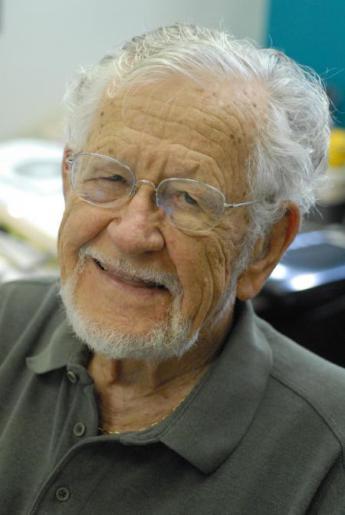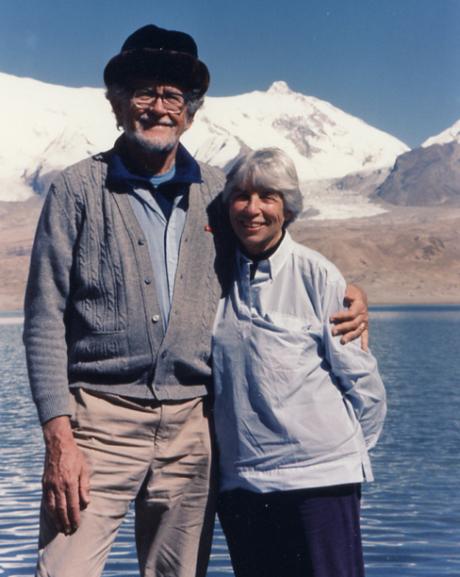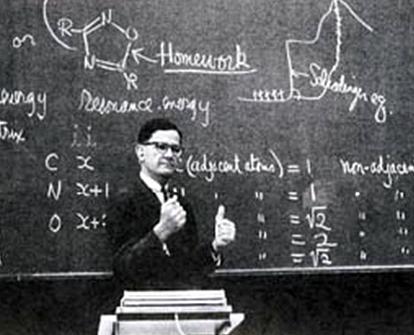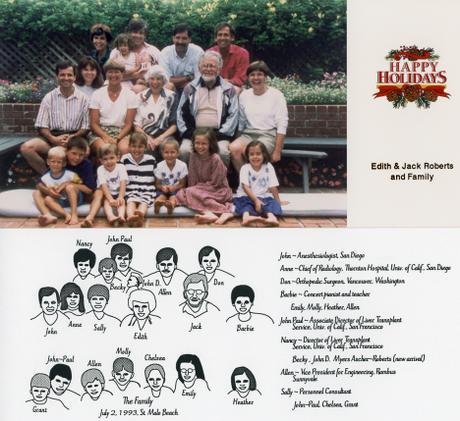
Jack Roberts
On October 29, 2016, John D. “Jack” Roberts, renowned scientist, professor, and pioneer in organic chemistry, died of a stroke at the age of 98. Roberts was a colleague of Linus Pauling’s at Caltech during the 1950s and early 1960s, and a friend until Pauling’s death in 1994. During a career at Caltech that spanned more than sixty years, Roberts served as chairman of the chemistry department as well as Institute vice president, provost, and dean of faculty. As a scientist, Roberts pioneered techniques in organic and physical chemistry and nuclear magnetic resonance spectroscopy (NMR). He also expanded the range of interdisciplinary study within the chemical sciences, focusing in particular on the application of experimental techniques of physical chemistry to organic molecules.
Jack Dombrowski Roberts was born in 1918 in Los Angeles, “where the freeways cross,” as he said in a 2007 interview. He developed an interest in science at an early age, and was particularly captivated by Einstein’s theory of relativity, taking advantage of his location to attend open houses held at Caltech while Einstein was a visiting professor. These events, as well as the opportunity to see Caltech’s impressive high voltage lab, made a deep impression on him growing up. Thus inspired, he and a cousin conducted frequent experiments in a home-built lab, sometimes resulting in accidents or explosions that warranted a visit to the doctor.
Although he wanted to attend Caltech, Roberts chose UCLA because of financial considerations. Even so, he worked six days a week at a bakery to pay for his tuition up until his sophomore year, when he accepted a research position. Because UCLA didn’t have a Ph.D. program in chemistry at the time, Roberts was enlisted to work as a lab assistant, a position that would have ordinarily gone to a doctoral candidate. (As a sophomore, Roberts learned the techniques of glass blowing so that he could make his own equipment.) In later years, Roberts reflected on this time fondly, recounting with a laugh some of the eccentricities of his lab mates, classmates, and UCLA professors. Indeed, he attributed most of his future success to the unique opportunities and relationships with faculty that he enjoyed during this time. Of particular note was his connection with Professor William G. Young, who became a close friend, and for whom Roberts wrote a biographical memoir when Young died in 1980.
Following a brief foray into graduate work at Penn State, the attack on Pearl Harbor called Roberts to return to UCLA. Once back, he worked on war projects related to oxygenation and deoxygenation. On July 11, 1942, he eloped with his high school sweetheart, Edith Johnson, and the pair settled happily in L.A. Edith had attended UC Berkeley for one and a half years before going into the insurance business to help support her family. While he was working on his thesis, Jack would wake up early with Edith and usually be the first person in the lab. Often Edith would come to his lab after work and fix dinner over a Bunsen burner. They were married for sixty-eight years, until Edith’s death in 2010

Jack and Edith Roberts
After completing his thesis in 1944, Roberts began lecturing at UCLA as a post-doc and pursuing his own research projects on cyclopropyl chloride. He enjoyed the position and the opportunity to exchange ideas with colleagues and students alike. One particular colleague, Paul Bartlett, made such a strong impression on him that he applied for and received a year-long National Research Council Fellowship to work with Bartlett at Harvard University. While there, Roberts continued his work on cyclopropyl chloride and began a new inquiry into metalation.
Roberts accepted a position at MIT after his fellowship, buoyed by the support of Arthur Cope, chair of the MIT Chemistry department. As chair, Cope was intent on changing the dynamic at MIT by inviting new professors to the campus and reinstating a strong research focus. Once settled, Roberts immersed himself in resonance theory and quantum chemistry. By then, Roberts had realized that quantum mechanics was slowly outranking more classical research practice, and he wanted his classes to reflect this shift, despite his relative inexperience with the subject. In order to do so, he taught himself the basics almost overnight, thus challenging himself nearly as much as his students.
While he was at MIT, Roberts also worked as a consultant for DuPont and became involved with research on molecular orbital theory, on which he published a few papers as well as a successful book. He incorporated these ideas into his lectures as well, and his students responded enthusiastically. Importantly, a colleague, Richard Ogg, introduced the concept of NMR to Roberts while he was affiliated with DuPont, but it was a few more years before the ideas really took told for Roberts.
Roberts recalled his time at MIT as fruitful, yet troubled. While he won more space for the chemistry department and enjoyed the motivated students with whom he worked, the department’s older faculty – those who dated to the era before Arthur Cope had become chair – held both Cope and Roberts in low regard. As such, when Ernest Swift offered him a job at Caltech in 1952, Roberts was quick to accept. Once arrived, he became acquainted with a number of extraordinary scientists, including Linus Pauling. Friends and former colleagues of Roberts expressed concerns that Pauling tended to overshadow the scientists with whom he worked, but Roberts and Pauling quickly established a mutual respect for one another. Roberts especially appreciated Pauling’s multidisciplinary exploration and his attention to teaching and inclusivity.
Their shared commitment to that last characteristic was demonstrated by the case of Dorothy Semenow, the first female graduate student at Caltech, whose enrollment Pauling and Roberts were instrumental in bringing about. In his later years, Roberts said that this milestone in Caltech’s history, was “clearly the best thing I have done at Caltech in the sixty years I’ve been here.” Semenow received her degree in chemistry and biology in 1955 and, after her admittance, Caltech relaxed its policies regarding gender, agreeing to accept female students who exhibited “exceptional” aptitude and who could prove that they were of the same high caliber as the Institute’s male students. Caltech went completely co-ed in the 1970s.

Roberts in lecture, 1962.
As he became more deeply involved with spectroscopy, Roberts garnered support from Pauling to bring NMR technology to Caltech, arguing that the the investment would give Institute chemists a powerful new structural tool to study organic compounds. Roberts had clearly chosen the right ally; not only did Pauling secure funding, he also assigned space for Roberts and his team to work in the newly constructed Church lab. In addition to the research that he conducted using the machine, Roberts was also responsible for maintaining it and expanding the scope of its use, tasks which proved alternately frustrating and rewarding.
Later on, space arose as a different sort of issue, when a disagreement arose over laboratory allocations for Pauling’s orthomolecular research. In 1963, newly appointed as chairman of the chemistry department, Roberts approached Pauling about giving up two of his rooms in order to fulfill promises that the department had made to newly appointed faculty. The issue was debated for weeks, with Pauling pushing for a different approach in which he would give up one room and share others, thereby yielding the same square footage while, in his view, using the spaces that he did have more efficiently.
Roberts rejected some of Pauling’s suggestions and accepted others in what he later remembered to be a reasonable and civilized resolution. Pauling saw the matter differently, claiming that Roberts had expressed little regard for his orthomolecular research. Though the issue of space allocation was ultimately passed on to a committee that came to a compromise requiring Pauling to give up less space than initially proposed, the conflict was one of many reasons why, at the end of 1963, Pauling ultimately decided to seek opportunities elsewhere.
When Pauling decided to leave Caltech, Roberts was the second person that Pauling told, the first being Ava Helen. Shortly after Pauling resigned, Roberts offered him an honorary position of sorts, as a research associate. Pauling accepted, with the caveat that he not have an office, a salary, or duties. But Pauling’s continuing involvement with Caltech was important to Roberts, who valued Pauling’s scientific legacy and never took issue with the political stances that had led to soured relationships with so many others in Pasadena. Reflecting specifically on Pauling’s work as an activist, Roberts said
It seems to me that, in the long run, you do better to be known as a bastion of integrity than as a weather vane, responsive only to the directions whence the money winds blow.
Though no longer close scientific colleagues, Pauling and Roberts continued to exchange letters and Christmas cards for the rest of Pauling’s life.

Roberts family holiday card, with accompanying diagram. 1993.
Meanwhile, Roberts was writing extensively. In 1959, he published Nuclear Magnetic Resonance, an influential text which included his own color illustrations. In 1977, he and Marjorie Caserio, one of his post-doctoral fellows, co-authored Basic Principles of Organic Chemistry, the manuscript of which Pauling had helped to edit. Roberts spoke with pride of sending his four children to Stanford by giving them the copyright to another successful book, Organic Chemistry: Methane to Macromolecules, which he co-authored with Ross Stewart. Roberts was also very active with the National Science Foundation, evaluating projects and grant proposals.
In 1980, Roberts received the Linus Pauling Medal from the Puget Sound and Oregon sections of the American Chemical Society, a distinction rewarding contributions to chemistry that have attracted national and international recognition. In 1987, Roberts received an even more prestigious decoration, the Priestley Medal, which is the highest honor bestowed by the American Chemical Society and an award that Pauling himself had received three years prior. In his acceptance speech, Roberts praised Caltech as having been “the ideal place” for him to pursue his scientific career. He likewise affirmed Pauling’s scientific work and his political activism as well, stating
I am glad that Linus is also associated with Priestley, not only for his contributions to chemistry, but even more for his adherence to the same high moral and social principles. Chemistry – indeed the world – needs more men and women with not only the ideas and Priestley and Pauling, but also with the same willingness to work to establish those ideals in a far-from-perfect world.
From 1980-1983, Roberts served as Caltech’s provost, vice president, and dean of faculty. He officially retired in 1988, but continued to mentor students well into his nineties as part of the Summer Undergraduate Research Fellowship at Caltech, providing the same inspiration and encouragement that he himself had received at the Institute’s open houses during his youth. Roberts also reveled in the achievements of his children and his students, writing, in his autobiography, “One does not achieve in a vacuum—people are needed, not only to help, but to appreciate.“
At the time of his death, Roberts had taught at Caltech for over sixty years and had earned honorary degrees from the University of Notre Dame, the University of Munich, and Temple University. In 1998, he was named one of the seventy-five most influential chemists of the last seventy-five years. He later received the National Academy of Science Award for Chemistry in Service to Society (2009) and the American Institute of Chemists Gold Medal (2013). He will be remembered as a pioneer in physical organic chemistry, an extraordinary scientist, and an invaluable mentor.
